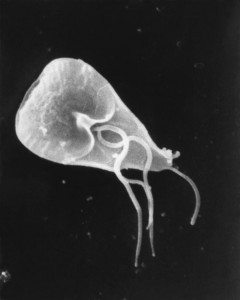When it comes to strenuous outdoor activities, hydration is a big issue. Especially in mountaineering, dehydration not only reduces performance but can also intensify problems with altitude sickness. A second issue is sometimes slightly overlooked: water treatment. In the Alps, water quality is usually no issue. In warmer (and poorer) countries however, water can be contaminated with bacteria, viruses and protozoa. All of them have one common denominator: explosive diarrhea. And this again ends in dehydration (and conjures up disturbing images). In a remote environment, such issues are not just uncomfortable but can be dangerous. As the (in)famously ineffective British Cho Oyu expedition in 1952 has shown, stomach problems can seriously upset the mood in a climbing party and wreck the schedule. But much worse, Reinhold Messner suffered from hallucinations, fever and almost complete exhaustion on the way down from Kangchenjunga due to a protozoa infection. The symptoms became particularly severe, just when a storm pinned down the climbing party around Camp 2 and Messner only made it out alive with incredible luck.
Fortunately, these days we have plenty of tools at our disposal than can reduce the risk of infection. Generally speaking, there are two lines of defense: the water can be filtered, removing any pathogens or pathogens can be destroyed and rendered ineffective. Outdoor Gear Lab has reviewed plenty of them. While I don’t agree with some of the conclusions, it provides a good starting point.
Let’s jump into some of the details: Filtering water requires very fine (often ceramic) filters that reliably remove objects as small as 0.1 – 0.2 mikron (10^-7). The impressive part is that such incredibly fine filters are actually available at around GBP100. This makes it possible to keep-out a variety of viruses, which are generally much smaller than protozoa or bacteria. Giardia, for instance, are about 2-3 mikro in diameter, 10x the size of many viruses. The operation of those filters is reasonably straight-forward but it requires careful separation of the parts that come into contact with contaminated water and those that are clean. The good thing is that they also keep out larger particles – no need for any additional equipment. On the downside, ceramic filters can be quite heavy. When trekking in higher altitude, this can be a problem.
More direct treatment is aimed at destroying the pathogens or their DNA so they cannot multiply and remain without effect. All of the pathogens only have one aim – make you produce more of them. Bacteria use the available nutrition and warmth inside your body to reproduce. Protozoa settle in the intestinal tract or other organs to ‘manufacture’ dormant replicas ready to infect new hosts. Viruses inject their DNA in your own cells and use those to produce new viruses. The best option to inhibit all of this is, of course, to always boil the water. If that is not an option, chemicals can help. A combination of silver-ions and chlorine is supposed to be quite effective. Treatment comes in liquid and tablet form. It can just be added to any bottle but usually requires a long time (several hours) for the water to be safe. When the water can contain parasites, make sure to get tablets that have both silver-iodine and chlorine, such as Katadyn Micropur Forte. While it makes the water safe to drink, it also alters its taste – and as you probably remember from swallowing water in any public pool – not to the better.
A faster way is to bombard the water with UV radiation. This very quickly brakes-up the DNA structure of pathogens without adding anything else to the water – just like the sun’s UV radiation breaks down your skin if your exposed for too long. Such tools require batteries (or some source of electricity) which makes them less reliable in some circumstances.
On the other hand, it is probably the simplest method and gives you the good feeling of going nuclear on those little suckers. One option is the SteriPEN. As with the chemicals, the water needs to be free of large particles, so it might be necessary to apply a coarse filter beforehand. You also need to be careful with the edges of bottles and cups as it only treats the actual water. Best practice is to use a separate container to collect the water, pour it carefully into a cup or bottle and then apply the UV radiation. For this year’s expedition to Nepal, I opted for the UV method combined with Chlorine tablets as backup (and additional safeguard). For my purposes, this seemed the optimal trade-off between weight, simplicity and reliability.
